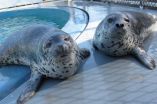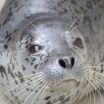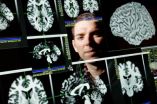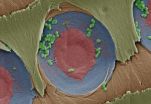(Press-News.org) Two spotted seals orphaned as pups in the Arctic are now thriving at UC Santa Cruz's Long Marine Laboratory, giving scientists a rare opportunity to learn about how these seals perceive their environment. In a comprehensive study of the hearing abilities of spotted seals, UCSC researchers found that the seals have remarkably sensitive hearing in both air and water.
The findings, published February 26 in the Journal of Experimental Biology, are important for understanding how spotted seals might be affected by noise from human activities in the rapidly changing Arctic environment. Reductions in sea ice due to climate change have led to increased shipping and industrial activity in the Arctic, including oil and gas exploration. Coauthor Colleen Reichmuth, director of the Pinniped Cognition and Sensory Systems Laboratory at UCSC, said few studies have been done on Arctic seals, which include the spotted seal, ringed seal, bearded seal, and several other species.
"We wanted to develop a better understanding of how Arctic seals use sound in their environment and how human intrusions and other changes in that environment may influence them," Reichmuth said.
Using a specialized acoustic chamber to test the spotted seals' hearing, the researchers measured the lowest hearing thresholds ever recorded for a marine mammal in air. "In their range of most sensitive hearing, they can detect airborne sounds as well as terrestrial carnivores, like cats and dogs," said Jillian Sills, a graduate student in ocean sciences at UC Santa Cruz and first author of the paper. This makes sense, because the seals have to be vigilant for predators such as polar bears when they haul out on the ice, which they do to rest, molt, give birth, and nurse their pups.
In water, the range over which the spotted seals' hearing is most sensitive covers a remarkable seven octaves. In fact, they hear almost as well in water as fully aquatic species such as dolphins and porpoises. While the cetaceans have better sensitivity to higher-frequency sounds, the seals hear better at lower frequencies. "These spotted seals actually hear much better in both air and water than was previously thought based on earlier data for harp seals and ringed seals," Sills said.
The researchers also looked at how noise in the environment can interfere with seals' hearing. This "masking data" can be used to estimate, for example, the size of the zone around a noise source within which a seal would be unable to hear another seal some distance away. "Quantitative estimates of zones of masking around particular noise sources are relevant for management decisions about the potential effects of noise on hearing," Sills said.
Overall, the hearing of spotted seals is very similar to that of harbor seals, a relatively well studied temperate species. "Our findings suggest that we can probably apply much of what we know about harbor seals to spotted seals. For harbor seals, we know a lot more about how different types of sounds interfere with hearing, and how their hearing sensitivity can be reduced after exposure to very loud sounds," Sills said.
The use of seismic "airguns" to map oil and gas reserves beneath the seafloor is a particular concern because they emit intense pulses of very loud noise. Depending on the survey, the pulses may be emitted every 10 to 20 seconds for days on end, and the low-frequency sound can travel long distances through the water. Little is known about the extent to which this kind of noise could cause behavioral disturbances, mask sounds the animals need to hear, or possibly cause hearing loss or physical harm to seals close to the source, Sills said.
"We don't know as much about behavioral effects as we would like to because it's so difficult to do research in the Arctic. At least now we are starting to learn about the hearing sensitivity of these seals, which is a first step toward understanding how they perceive sound in air and water, and how they might be influenced by increasing noise levels," she said.
Reichmuth said the researchers were not surprised to find that spotted seals have sensitive hearing, despite earlier reports suggesting otherwise. "Because they're hunting under water and living in dark conditions for parts of the year, we assumed that hearing would be an important sensory modality," she said.
Although spotted seals are not considered threatened or endangered in U.S. waters, the loss of sea ice in the Arctic is a concern for the future of these and other ice seals. Sills emphasized that any potential impacts of increased noise on ice seals must be considered in the context of other threats. "It's difficult to separate out impacts from multiple sources. These animals will have to deal with the combination of multiple changes in their environment happening at the same time," she said.
The two spotted seals at Long Marine Lab, named Amak and Tunu, are the only spotted seals in captivity outside of Japan. The researchers are currently conducting similar hearing sensitivity studies with two ringed seals at the lab, and they hope to be able eventually to study bearded seals as well.
In addition to Sills and Reichmuth, Brandon Southall, an adjunct researcher at UCSC's Institute of Marine Sciences and president of SEA, Inc., contributed to the spotted seal study and is a coauthor of the paper. This research was funded by the International Association of Oil and Gas Producers through their E&P Joint Industry Program on Sound and Marine Life.
INFORMATION:
Spotted seal study reveals sensitive hearing in air and water
Increased human activity in the Arctic means ice seals are encountering more noise and other impacts, yet little is known about these species
2014-02-27
ELSE PRESS RELEASES FROM THIS DATE:
Secondhand smoke exposure linked to adverse pregnancy outcomes
2014-02-27
BUFFALO, N.Y. — Secondhand smoking is linked with pregnancy loss, including miscarriage, stillbirth and tubal ectopic pregnancy, according to new research from scientists at Roswell Park Cancer Institute (RPCI) and the University at Buffalo (UB). The study findings, published online by the journal Tobacco Control, mark a significant step toward clarifying the risks of secondhand smoke exposure.
"This study demonstrated that pregnancy outcomes can be correlated with secondhand smoking. Significantly, women who have never smoked but were exposed to secondhand smoke were ...
Febrile illnesses in children most often due to viral infections
2014-02-27
This news release is available in German. Most children ill with fever in Tanzania suffer from a viral infection, a new study published in the New England Journal of Medicine shows. A research team led by Dr. Valérie D'Acremont from the Swiss Tropical and Public Health Institute in Basel and the Policlinique Médicale Universitaire in Lausanne systematically assessed the causes of febrile illnesses in Tanzanian children. According to the results, in most cases a treatment with antimalarials or antibiotics is not required. The finding has the potential to improve the ...
Breast cancer cells less likely to spread when one gene is turned off
2014-02-27
COLUMBUS, Ohio – New research suggests that a protein only recently linked to cancer has a significant effect on the risk that breast cancer will spread, and that lowering the protein's level in cell cultures and mice reduces chances for the disease to extend beyond the initial tumor.
The team of medical and engineering researchers at The Ohio State University previously determined that modifying a single gene to reduce this protein's level in breast cancer cells lowered the cells' ability to migrate away from the tumor site.
In a new study published in the journal ...
One gene influences recovery from traumatic brain injury
2014-02-27
CHAMPAIGN, Ill. — Researchers report that one change in the sequence of the BDNF gene causes some people to be more impaired by traumatic brain injury (TBI) than others with comparable wounds.
The study, described in the journal PLOS ONE, measured general intelligence in a group of 156 Vietnam War veterans who suffered penetrating head wounds during the war. All of the study subjects had damage to the prefrontal cortex, a brain region behind the forehead that is important to cognitive tasks such as planning, problem-solving, self-restraint and complex thought.
The ...
Caesarean babies are more likely to become overweight as adults
2014-02-27
Babies born by caesarean section are more likely to be overweight or obese as adults, according to a new analysis.
The odds of being overweight or obese are 26 per cent higher for adults born by caesarean section than those born by vaginal delivery, the study found (see footnote).
The finding, reported in the journal PLOS ONE, is based on combined data from 15 studies with over 38,000 participants.
The researchers, from Imperial College London, say there are good reasons why many women should have a C-section, but mothers choosing a caesarean should be aware that ...
Cows are smarter when raised in pairs
2014-02-27
Cows learn better when housed together, which may help them adjust faster to complex new feeding and milking technologies on the modern farm, a new University of British Columbia study finds.
The research, published today in PLOS ONE, shows dairy calves become better at learning when a "buddy system" is in place. The study also provides the first evidence that the standard practice of individually housing calves is associated with certain learning difficulties.
"Pairing calves seems to change the way these animals are able to process information," said Dan Weary, corresponding ...
Impact on mummy skull suggests murder
2014-02-27
Blunt force trauma to the skull of a mummy with signs of Chagas disease may support homicide as cause of death, which is similar to previously described South American mummies, according to a study published February 26, 2014 in PLOS ONE by Stephanie Panzer from Trauma Center Murau, Germany, and colleagues, a study that has been directed by the paleopathologist Andreas Nerlich from Munich University.
For over a hundred years, the unidentified mummy has been housed in the Bavarian State Archeological Collection in Germany. To better understand its origin and life history, ...
Tree branch filters water
2014-02-27
A small piece of freshly cut sapwood can filter out more than 99 percent of the bacteria E. coli from water, according to a paper published in PLOS ONE on February 26, 2014 by Michael Boutilier and Jongho Lee and colleagues from MIT.
Researchers were interested in studying low-cost and easy-to-make options for filtering dirty water, a major cause of human mortality in the developing world. The sapwood of pine trees contains xylem, a porous tissue that moves sap from a tree's roots to its top through a system of vessels and pores. To investigate sapwood's water-filtering ...
Waterbirds' hunt aided by specialized tail
2014-02-27
The convergent evolution of tail shapes in diving birds may be driven by foraging style, according to a paper published in PLOS ONE on February 26, 2014 by Ryan Felice and Patrick O'Connor from Ohio University.
Birds use their wings and specialized tail to maneuver through the air while flying. It turns out that the purpose of a bird's tail may have also aided in their diversification by allowing them to use a greater variety of foraging strategies. To better understand the relationship between bird tail shape and foraging strategy, researchers examined the tail skeletal ...
MIT researchers make a water filter from the sapwood in tree branches
2014-02-27
If you've run out of drinking water during a lakeside camping trip, there's a simple solution: Break off a branch from the nearest pine tree, peel away the bark, and slowly pour lake water through the stick. The improvised filter should trap any bacteria, producing fresh, uncontaminated water.
In fact, an MIT team has discovered that this low-tech filtration system can produce up to four liters of drinking water a day — enough to quench the thirst of a typical person.
In a paper published this week in the journal PLoS ONE, the researchers demonstrate that a small ...
LAST 30 PRESS RELEASES:
Making lighter work of calculating fluid and heat flow
Normalizing blood sugar can halve heart attack risk
Lowering blood sugar cuts heart attack risk in people with prediabetes
Study links genetic variants to risk of blinding eye disease in premature infants
Non-opioid ‘pain sponge’ therapy halts cartilage degeneration and relieves chronic pain
AI can pick up cultural values by mimicking how kids learn
China’s ecological redlines offer fast track to 30 x 30 global conservation goal
Invisible indoor threats: emerging household contaminants and their growing risks to human health
Adding antibody treatment to chemo boosts outcomes for children with rare cancer
Germline pathogenic variants among women without a history of breast cancer
Tanning beds triple melanoma risk, potentially causing broad DNA damage
Unique bond identified as key to viral infection speed
Indoor tanning makes youthful skin much older on a genetic level
Mouse model sheds new light on the causes and potential solutions to human GI problems linked to muscular dystrophy
The Journal of Nuclear Medicine ahead-of-print tip sheet: December 12, 2025
Smarter tools for peering into the microscopic world
Applications open for funding to conduct research in the Kinsey Institute archives
Global measure underestimates the severity of food insecurity
Child survivors of critical illness are missing out on timely follow up care
Risk-based vs annual breast cancer screening / the WISDOM randomized clinical trial
University of Toronto launches Electric Vehicle Innovation Ontario to accelerate advanced EV technologies and build Canada’s innovation advantage
Early relapse predicts poor outcomes in aggressive blood cancer
American College of Lifestyle Medicine applauds two CMS models aligned with lifestyle medicine practice and reimbursement
Clinical trial finds cannabis use not a barrier to quitting nicotine vaping
Supplemental nutrition assistance program policies and food insecurity
Switching immune cells to “night mode” could limit damage after a heart attack, study suggests
URI-based Global RIghts Project report spotlights continued troubling trends in worldwide inhumane treatment
Neutrophils are less aggressive at night, explaining why nighttime heart attacks cause less damage than daytime events
Menopausal hormone therapy may not pose breast cancer risk for women with BRCA mutations
Mobile health tool may improve quality of life for adolescent and young adult breast cancer survivors
[Press-News.org] Spotted seal study reveals sensitive hearing in air and waterIncreased human activity in the Arctic means ice seals are encountering more noise and other impacts, yet little is known about these species






